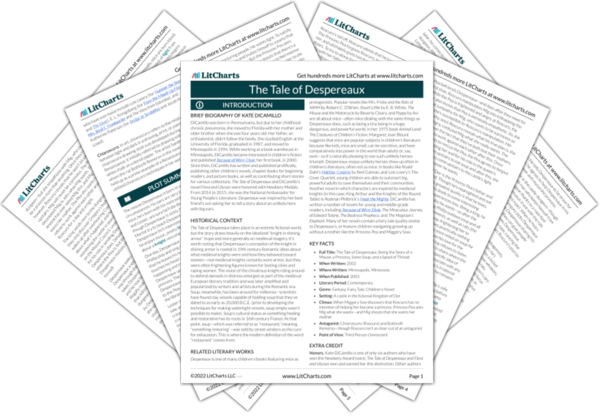Welcome to the LitCharts study guide on Kate DiCamillo's The Tale of Despereaux. Created by the original team behind SparkNotes, LitCharts are the world's best literature guides.
The Tale of Despereaux: Introduction
The Tale of Despereaux: Plot Summary
The Tale of Despereaux: Detailed Summary & Analysis
The Tale of Despereaux: Themes
The Tale of Despereaux: Quotes
The Tale of Despereaux: Characters
The Tale of Despereaux: Symbols
The Tale of Despereaux: Theme Wheel
Brief Biography of Kate DiCamillo

Historical Context of The Tale of Despereaux
Other Books Related to The Tale of Despereaux
- Full Title: The Tale of Despereaux: Being the Story of a Mouse, a Princess, Some Soup, and a Spool of Thread
- When Written: 2002
- Where Written: Minneapolis, Minnesota
- When Published: 2003
- Literary Period: Contemporary
- Genre: Fantasy; Fairy Tale; Children’s Novel
- Setting: A castle in the fictional Kingdom of Dor
- Climax: When Miggery Sow discovers that Roscuro has no intention of helping her become a princess, Princess Pea asks Mig what she wants—and Mig shouts that she wants her mother.
- Antagonist: Chiaroscuro (Roscuro) and Botticelli Remorso—though Roscuro isn’t as clear-cut of an antagonist
- Point of View: Third Person Omniscient
Extra Credit for The Tale of Despereaux
Honors. Kate DiCamillo is one of only six authors who have won the Newbery Award twice; The Tale of Despereaux and Flora and Ulysses won and earned her this distinction. Other authors who have won twice include Lois Lowry (for Number the Stars and The Giver), E. L. Konigsberg (for From the Mixed-Up Files of Mrs. Basil E. Frankweiler and The View from Saturday), and Katherine Paterson (for Bridge to Terabithia and Jacob Have I Loved).
Chiaroscuro. In art, chiaroscuro refers to the relationship between light and dark in a drawing, print, or painting. The chiaroscuro drawing style was developed during the Renaissance; it initially referred to drawing with charcoal and white chalk on colored paper. The artist Sandro Botticelli—for whom the rat Botticelli Remorso in the novel is named—is often held up as a prime example of a Renaissance painter who utilized chiaroscuro techniques in his work.







